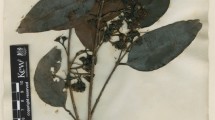Summary
Stylosanthes is a mainly New World genus comprising about 25 species but some of them are currently poorly defined. The genus is economically important, especially for low input agricultural production systems in the tropics and subtropics. During recent research on Stylosanthes taxonomy it became apparent that the species Stylosanthes hispida had never been formally typified. In order to foster taxonomic stability within the genus Stylosanthes, we here propose a lectotype for S. hispida. Additionally, some nomenclatural comments are provided.


Similar content being viewed by others
References
Calles, T. & Schultze-Kraft, R. (2010). Stylosanthes (Leguminosae, Dalbergieae) of Venezuela. Willdenowia 40: 305 – 329.
Chakraborty, S. (ed.) (2004). High-yielding anthracnose-resistant Stylosanthes for agricultural systems. ACIAR Monograph No. 111. Australian Centre for International Agricultural Research, Canberra.
CONABIO (Comisión Nacional para el Conocimiento y Uso de la Biodiversidad) (2008). Capital natural de México, Vol. 1, Conocimiento actual de la biodiversidad. Comisión Nacional para el Conocimiento y Uso de la Biodiversidad, Ciudad de México.
Cook, B. G., Pengelly, B. C., Brown, S. D., Donnelly, J. L., Eagles, D. A., Franco, M. A., Hanson, J., Mullen, B. F., Partridge, I. J., Peters, M. & Schultze-Kraft, R. (2005). CD-ROM. Tropical forages: An interactive selection tool. Commonwealth Scientific and Industrial Research Organisation, Brisbane; Queensland Department of Primary Industries and Fishery, Brisbane; International Center for Tropical Agriculture, Cali; International Livestock Research Institute, Nairobi.
Klitgaard, B. B. & Lavin, M. (2005). Tribe Dalbergieae sens. lat. In: G. Lewis, B. Schrire, B. Mackinder & M. Lock (eds), Legumes of the world, pp. 307 – 335. Royal Botanic Gardens, Kew.
Mannetje, L. ’t (1984). Considerations on the taxonomy of the genus Stylosanthes. In: H. M. Stace & L. A. Edye (eds), The biology and agronomy of Stylosanthes, pp. 1 – 21. Academic Press, Sydney.
McNeill, J., Barrie, F. R., Buck, W. R., Demoulin, V., Greuter, W., Hawksworth, D. L., Herendeen, P. S., Knapp, S., Marhold, K., Prado, J., Prud’Homme van Reine, W. F., Smith, G. F., Wiersema, J. H. & Turland, N. J. (eds). (2012). International Code of Nomenclature for algae, fungi, and plants (Melbourne Code): Adopted by the Eighteenth International Botanical Congress Melbourne, Australia, July 2011. Regnum Veg. 154. Koeltz Scientific Books, Königstein.
Mohlenbrock, R. H. (1957). Revision of the genus Stylosanthes. Ann. Missouri Bot. Gard. 44: 299 – 355.
Nooteboom, H. P. (1961). Stylosanthes Swartz. Reinwardtia 5: 446 – 450.
Richard, L. C. (1792). Catalogus plantarum, ad societatem, ineunte anno 1792, e Cayenna missarum a domino Le Blond. Actes Soc. Hist. Nat. Paris 1: 105 – 114.
Stafleu, F. A. & Cowan, R. S. (1983). Taxonomic literature: A selective guide to botanical publications and collections with dates, commentaries and types, ed. 2, Vol. 4. Bohn, Scheltema & Holkema, Utrecht/Antwerp; Dr. W. Junk b.v. Publishers, The Hague/Boston.
Thiers, B. (2008). Index herbariorum: A global directory of public herbaria and associated staff. Published at http://sweetgum.nybg.org/ih/. The New York Botanical Garden, New York.
Turland, N. (2013). The code decoded: A user’s guide to the International Code of Nomenclature for algae, fungi, and plants. Regnum Veg. 155. Koeltz Scientific Books, Königstein.
Acknowledgements
We thank Ms Claudia Gonçalves and Dr Marc Jeanson for the assistance given to the first author during his stay at P. The financial support of the Eiselen Foundation, Ulm, Germany; the Foundation Gran Mariscal de Ayacucho (Fundayacucho), Caracas, Venezuela; the German Academic Exchange Service (DAAD), Bonn, Germany; and SYNTHESYS (synthesys.info) is acknowledged. Last but not least, the authors would like to thank the two anonymous reviewers, who made important suggestions for improving the final manuscript.
Author information
Authors and Affiliations
Corresponding author
Rights and permissions
About this article
Cite this article
Calles, T., Schultze-Kraft, R. Lectotypification of Stylosanthes hispida (Leguminosae). Kew Bull 72, 4 (2017). https://doi.org/10.1007/s12225-017-9679-4
Accepted:
Published:
DOI: https://doi.org/10.1007/s12225-017-9679-4




